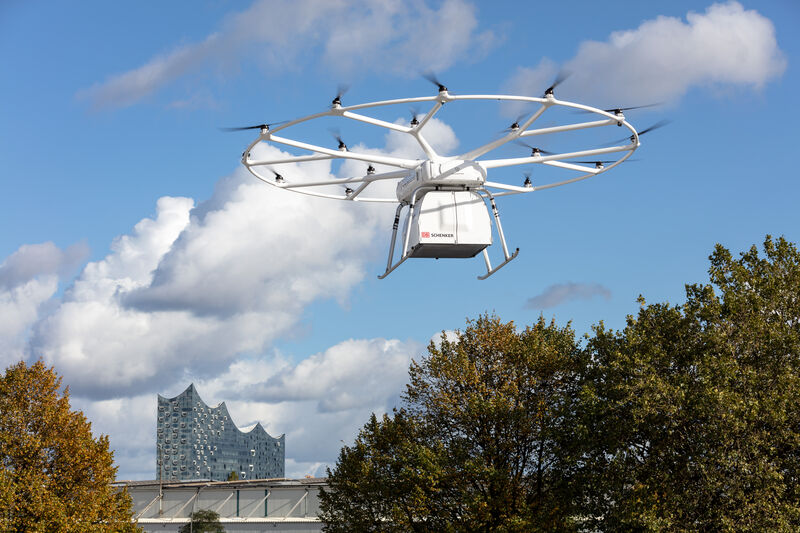
Photo: Volocopter
Volocopter unveils heavy-lift delivery drone at ITS World Congress
13 October 2021
by Christopher Carey
Volocopter’s heavy-duty delivery VoloDrone took to the skies yesterday for its first public test flight on the sidelines of the ITS World Congress 2021 in Hamburg.
The three-minute flight – undertaken with German logistics firm DB Schenker – took off from the city’s homePORT innovation campus where it reached an altitude of 22 metres.
The drone uses 18 rotors, a battery and electric motors to hoist itself into the air, using a rail attachment system in between its landing gear to carry loads of up to 200kg over a 40km range.
“Our VoloDrone will make existing logistics processes more robust, efficient, and sustainable,” said Volocopter CEO Florian Reuter.
“DB Schenker is an invaluable partner in our endeavour to untap the massive potential of our VoloDrone’s logistics use cases.”
The drone is 9.15 metres in diameter, 2.15 metres high, and has a 600kg maximum take-off weight (MTOW).
DB Schenker, a subsidiary of Germany’s national rail operator, Deutsche Bahn, launched its partnership with the firm last year.
Erik Wirsing, Vice President Global Innovation, DB Schenker, said: “Volocopter has proven again that they are the ideal partner for DB Schenker’s ambition to rethink global supply chains and bring transport logistics to the next dimension for our customers while saving emissions.”
Since launching the VoloDrone in 2019, Volocopter has carried out several flights in closed test areas around Germany, but yesterday’s flight was the first time the drone has operated in a public environment.
Roadmap
In March 2021, Volocopter – best known for its flying air taxis – published a 52-page whitepaper The Roadmap to Scalable Urban Air Mobility, covering topics from physical infrastructure and energy requirements to staff training.
As well as providing technical and operational details, the whitepaper offers a glimpse into the complexity of the ecosystem around the aircraft, and gives an overview of what urban air mobility (UAM) is, what progress has been made, and how the firm plans to implement its UAM services in cities like Singapore and Paris with a scalable business approach.
In September 2020, the World Economic Forum (WEF) and the City of Los Angeles released a roadmap to support the roll-out of UAM in cities globally.
Principles of the Urban Sky was developed over nine months through a collaboration of more than 50 manufacturers, service providers, infrastructure developers, academics, community organisations and government planners.
It set out seven guiding principles for UAM: sustainability, safety, equity of access, low noise, multimodal connectivity, local workforce development and purpose-driven data-sharing.
Image: Volocopter











